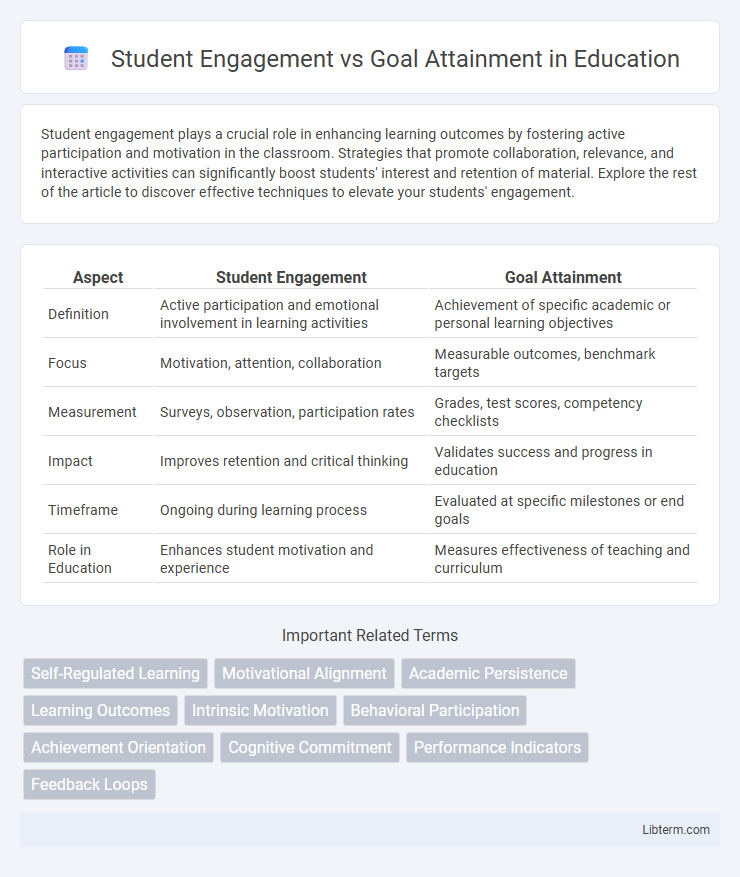Student engagement plays a crucial role in enhancing learning outcomes by fostering active participation and motivation in the classroom. Strategies that promote collaboration, relevance, and interactive activities can significantly boost students' interest and retention of material. Explore the rest of the article to discover effective techniques to elevate your students' engagement.
Table of Comparison
| Aspect | Student Engagement | Goal Attainment |
|---|---|---|
| Definition | Active participation and emotional involvement in learning activities | Achievement of specific academic or personal learning objectives |
| Focus | Motivation, attention, collaboration | Measurable outcomes, benchmark targets |
| Measurement | Surveys, observation, participation rates | Grades, test scores, competency checklists |
| Impact | Improves retention and critical thinking | Validates success and progress in education |
| Timeframe | Ongoing during learning process | Evaluated at specific milestones or end goals |
| Role in Education | Enhances student motivation and experience | Measures effectiveness of teaching and curriculum |
Understanding Student Engagement
Understanding student engagement involves analyzing emotional, behavioral, and cognitive dimensions that influence participation and motivation in learning activities. High engagement levels correlate with improved goal attainment, as engaged students are more likely to invest effort, persist through challenges, and achieve academic objectives. Measuring engagement through surveys, observations, and academic performance provides insights that help customize instructional strategies to enhance learning outcomes.
Defining Goal Attainment in Education
Goal attainment in education measures the extent to which students achieve predefined learning objectives, reflecting the effectiveness of instructional strategies and curriculum alignment. It involves assessing cognitive, behavioral, and affective outcomes to ensure educational goals are met and students demonstrate mastery of content. Quantitative tools like standardized tests and qualitative evaluations such as portfolios help educators track progress and adjust teaching methods for optimal goal fulfillment.
The Relationship Between Engagement and Achievement
Student engagement, characterized by active participation, emotional involvement, and cognitive investment, directly influences goal attainment by enhancing motivation and persistence in learning activities. Research consistently demonstrates that higher levels of engagement correlate with improved academic achievement, as engaged students are more likely to set, pursue, and accomplish educational goals. Effective strategies fostering engagement, such as interactive learning and personalized feedback, strengthen this relationship and drive measurable improvements in student performance.
Factors Influencing Student Engagement
Student engagement is heavily influenced by factors such as instructional quality, relevance of content, and classroom environment, which directly impact goal attainment. High engagement levels often correlate with clear learning objectives, interactive teaching methods, and supportive peer interactions, enhancing academic achievement. Motivation, self-efficacy, and access to resources also play critical roles in sustaining engagement and achieving educational goals.
Barriers to Goal Attainment in Learning
Barriers to goal attainment in learning often include low student engagement, which undermines motivation and focus critical for academic success. Distractions, lack of relevance in coursework, and insufficient feedback contribute significantly to disengagement, impeding goal progress. Overcoming these barriers requires strategies that enhance active participation, personalized learning, and continuous support to bridge the gap between engagement and achievement.
Strategies to Boost Student Engagement
Implementing active learning techniques, such as collaborative projects and interactive discussions, significantly enhances student engagement and thereby improves goal attainment. Utilizing technology tools like gamification and real-time feedback platforms fosters motivation and personalized learning experiences. Regularly setting clear, achievable objectives paired with continuous assessment helps maintain focus and drives measurable academic progress.
Setting SMART Academic Goals
Setting SMART academic goals enhances student engagement by providing Specific, Measurable, Achievable, Relevant, and Time-bound objectives that clarify expectations and track progress. Students with clear, structured goals exhibit higher motivation and improved focus, directly influencing goal attainment and academic performance. Incorporating SMART goals into learning strategies fosters accountability and encourages persistent effort towards academic success.
Measuring Engagement and Goal Progress
Measuring student engagement involves tracking behavioral indicators such as attendance, participation, and time-on-task, alongside emotional and cognitive dimensions through surveys and observational data. Goal attainment is assessed by setting specific, measurable objectives and evaluating progress via formative assessments, performance metrics, and self-reports. Combining these data points provides a comprehensive view of how engagement influences the achievement of academic goals.
Technology’s Role in Engagement and Attainment
Technology enhances student engagement by providing interactive tools such as educational software, virtual simulations, and real-time feedback systems that cater to diverse learning styles. Increased engagement through technology correlates with improved goal attainment, evidenced by higher test scores and deeper conceptual understanding across various subjects. Adaptive learning platforms use data analytics to personalize instruction, ensuring that students meet specific learning objectives efficiently.
Best Practices for Aligning Engagement with Success
Maximizing student engagement through interactive and personalized learning strategies significantly enhances goal attainment by fostering intrinsic motivation and deeper understanding. Implementing formative assessments and continuous feedback loops ensures that engagement activities are aligned with specific learning objectives, promoting measurable progress. Leveraging technology tools such as adaptive learning platforms and gamification can tailor experiences to individual student needs, driving sustained participation and improved academic outcomes.
Student Engagement Infographic

 libterm.com
libterm.com